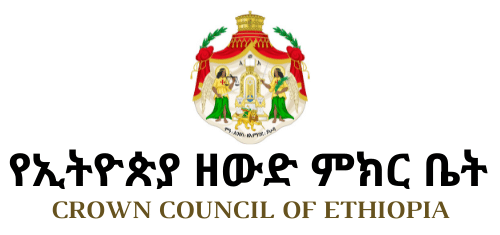
The Order of Solomon was established initially as a collar by Ras Tafari Makonnen in 1922 — whilst he was still Regent under Empress Zauditu — “to be awarded to foreign Kings who had the rank according to Emperor”1Emperor Haile Selassie: My Life and Ethiopia’s Progress, 1892-1937. Oxford, 1974, p.69.
But it seems likely that the collar was not awarded until after his coronation as Emperor in 1930. The Collar was originally envisaged by Emperor Haile Selassie, it is believed, as the highest rank of the Order of Solomon’s Seal, created by Emperor Yohannes IV in 1874, which was itself often referred to as “the Order of Solomon”, but became a separate order which was awarded only rarely.
The Order was originally referred to as “The Cross of Solomon”, and even during Menelik’s reign was in five classes plus “une categorie spéciale”, according to authoritative accounts published in 1913.2Montandon, Dr George: Au Pays Ghimirra: Récit de mon voyage à travers le Massif Éthiopien. Neuchatel, France, 1913: Bulletin de la Société Neuchateloise de Géographie, Tome XXII, 1913, printed by Imprimerie Attingen Friènes, Neutchatel.
French explorer Dr George Montandon, a graduate of the Société de Geographie of Paris, had spent two years in Ethiopia’s Ghimirra region, in the country’s south-west, and had extensively documented a wide range of natural and cultural phenomena. His paper, like many published by the French, provides detailed and scholarly background on Ethiopian history and geography not published in any other language. Dr Montandon said that Emperor Yohannes created the order of the “Cross of Solomon” possibly at the instigation of his Italian counsellor, Sr Naretti, and that he had created it in three classes, initially. These were, initially, the Premier (or First) Grade (Fitagnia Maëreg); the Second Grade (Houlatagnia Maëreg); and the Third Grade (Sostagnia Maëreg).
The idea for a Grand Collar of the Grand Cross Order of the Cross of Solomon, specifically designed to be given to foreign monarchs, came, according to Montandon’s 1913 paper, from Sir J. L. Harrington, the British Minister to Ethiopia [“Vers cette même époque fut adoptée, sur les conseils de Sir J. L. Harrington, Ministre d’Angleterre, une catégorie spéciale de la grand croix de Salomon, la grand’croix avec grand cordon vert, uniquement destinée aux souverains.”3Montandon, Op Cit. Page 411
The concept and design of this order may have been influenced by its Savoyard counterpart, the Order of the Annunziata, which the Emperor Haile Selassie held from King Victor Emannuel III. Paris jeweller Arthus-Bertrand has apparently been the principal maker of this Order.
The Order of Solomon is limited to the Emperor, Empress, Crown Prince, Crown Princess, President of the Crown Council, and Viceroy of Ethiopia, and reigning monarchs of any religion. Having said that, Le’ul Ras Kassa Hailu, President of the Crown Council (1941-1957) was the only Ethiopian apart from Alga-Worrach Asfa Wossen (later Emperor Amha Selassie I), Prince Makonnen and Princess Tenagne Work to be awarded the “Collar of the Seal of Solomon”. The Le’ul Ras was given the honour in 1955.4HH Prince Asfa-Wossen Asserate, in correspondence to the author, June 30, 1998.
Recipients have included Shah Reza Pahlavi of Iran, and Emperor Hirohito of Japan. The Order was also bestowed, in 1945, on King Gustav V, of Sweden, and on Swedish Crown Prince (as he then was) Gustaf Adolf.5Archives of the Swedish Orders of Chivalry.
King George V, of the United Kingdom, also received the Collar, in 1935, and his particular example of the Order’s chain, medal and star is illustrated in the book, Royal Insignia6jPatterson, Stephen. Royal Insignia. British and Foreign Orders of Chivalry From the Royal Collection. London, 1996: Merrell Holberton Publishers. pp.176-179. The chain has 44 square links of gold set with a Star of David, surrounded by a filigree border. The suspension is set with a square-cut ruby. On 11 squares, the Ge’ez inscription says: Amlakäna Haylenä Wäsawannä (Our God, Our Strength, Our Protector). The badge shows crowned Lions of Judah supporting a Star of David with cross within, under an Imperial Ethiopian crown. Left this is a gold badge, the tips set with eight pear-shaped diamonds, four emeralds and three rubies. In the centre, on two oval platinum plates: on the left, a pictorial representation of the phrase from Psalms 68, “Ethiopia shall reach her hand unto God” with the text in Ge’ez around it to the left; on the right platinum plate is an illustration of the Queen of Sheba meeting King Solomon, with the inscription “The Queen of Sheba Came to Hear Solomon’s Wisdom” around it to the right. The two ovals are themselves surrounded by two branches of palm leaves.7 The British book, Royal Insignia, by Stephen Patterson, which is the definitive work on the British and Foreign Orders of Chivalry from the [British] Royal Collection, said on page 176 that the right oval showed Ethiopia handing divine authority to the King-elect. This, as noted above, is incorrect; the oval picture shows the Queen of Sheba coming to hear the wisdom of Solomon. The breast star is the same as the badge, but without the suspension device.
The Order presented to King George V may have been the most ornate example produced. There are a number of variations of it, and there is some suggestion that it had been intended that the star and badge were to have been (and in some cases may have been) the same as what is now referred to as the Order of Solomon’s Seal [see below], the sister order. However, the insignia evolved very differently in the Order of Solomon’s Seal.
British sovereigns King George VI and Queen Elizabeth II have also received the Order, as did Queen Juliana of the Netherlands.
Holders of the Order may identify themselves with the use of the post-nominal initials KS or DS (Knight or Dame of the Order of Solomon).


